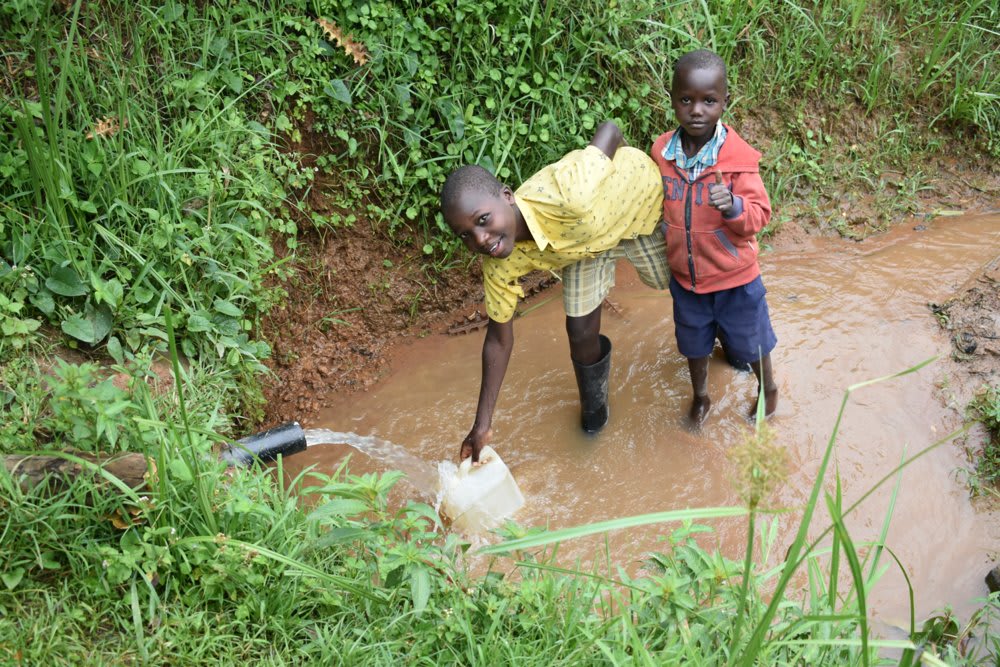March, 2021: Shisia Spring Project Complete!
Maraba Community now has access to clean water! We transformed Shisia Spring into a flowing source of water thanks to your donation. Our team protected the spring and trained the community on improved sanitation and hygiene practices, including COVID-19 prevention.

Fetching water from the newly protected spring.
"I am a farmer. With water around my farm, it will be easier for me to irrigate my farm during dry seasons. I will no longer wait for rainy seasons for me to plant my vegetables," said Doreen Akhaoya.
"I have been longing to expand my farming business, and with the reliable water, I will now be able to have more produce and sell to the market."

Doreen Akhaoya stands proudly at the spring.
Children were just as excited as the adults about the new water point.
"In the past, we were not sure if the water we drank was clean, and most of the time, we suffered from stomach illnesses. Now that we are sure our water is clean, we will live a healthy life free from diseases," said Juma, a secondary-school student in the community.
"I want to become an engineer in the future. With safe and clean water, I will have a healthy life; I will have more time to concentrate on my studies and achieve my goals."

Preparing for Spring Protection
Community members worked together to source and carried all locally available construction materials to the spring. These included bricks, sand, stones, and fencing poles. Some people also chiseled away at large stones to break them down into the gravel. Because people have to carry most items by hand, the materials collection process can take anywhere from a few weeks to months.

Community members of all ages helped mobilize materials, like bricks, for construction.
When everything was prepared, we sent a lorry to the community to deliver the rest of the construction materials, including the cement, plastic tarps, and hardware. Then, our artisan and field officers deployed to the spring to begin work. Individual households provided meals throughout each day to sustain the work team.

A woman carries sod to plant at the spring.
From Open Source to Protected Spring: A Step-by-Step Process
At last, it was time to dig in at the spring! Women and men lent their strength to the artisan each day to help with the manual labor. First, we cleared and excavated the spring area. We dug a drainage channel below the spring and several surface runoff diversion channels above and around the spring. These help to divert environmental contaminants carried by the rains away from the spring.

Excavation begins.
To ensure community members could still fetch water throughout the construction process, we also dug temporary diversion channels from the spring’s eye around the construction site. This allowed water to flow without severely disrupting community members’ water needs or the construction work.

Bricklaying
Excavation created space for setting the spring’s foundation made of thick plastic tarp, wire mesh, concrete, and waterproof cement. After setting the base, we started brickwork to build the headwall, wing walls, and stairs.
The terrain around this spring is particularly steep. One woman named Sheila, who has a physical disability, uses the spring every day for her chores but has challenges on the slope with her crutch. Children and women who are pregnant also struggle on the hill. With these challenges in mind, the community decided to mobilize five additional wheelbarrows, each of stones and sand, to contribute two additional bags of cement to lengthen the staircase leading to the stairs. These additional stairs will help improve access to the water point for all.

Sheila leaving the completed spring with water.
Next, we began one of the most crucial spring protection steps to ensure a fully functional water point: setting the discharge pipe. The discharge pipe has to be low enough in the headwall so that the water level inside never rises above the spring’s eye, yet high enough to leave eighteen to twenty inches between the pipe and the spring floor to allow room for the average jerrycan (a 20-liter container) to sit beneath the pipe without making contact.

Setting the pipe.
If the discharge pipe were placed too high above the spring’s eye, too much backpressure could force the flow to emerge elsewhere. Too low, and community members would not be able to access the water easily. We embedded the pipe using clay (or mortar when the clay is in short supply) and placed it at a slight incline to ensure water flows in the right direction.

Plastering the stone pitching.
In coordination with brickwork, we pitched medium to large stones on both sides of the spring’s drainage channel. We then cemented and plastered each stone group into place, forming the rub walls. These help to discourage people and animals from trying to stand on that area, which could cause soil erosion and thus a clogged drainage area.

Plasterwork
With brickwork and stone pitching completed, we turned to cementing and plastering both sides of the headwall and wing walls. These finishing layers reinforce the brickwork and prevent water in the reservoir from seeping through the walls. In turn, enough pressure builds in the reservoir box to push water out through the discharge pipe.

Reinforcing the headwall with clay.
As the headwall and wing walls were curing, we cemented and plastered the stairs and installed four tiles beneath the discharge pipe. The tiles protect the concrete from the falling water's erosive force while also beautifying the spring and facilitating easy cleaning of the spring floor.

Backfilling with stones.
We transitioned to the final stages of construction with the tiles in place - backfilling the reservoir box. First, we cleared the collection box of any debris that may have fallen in since its construction, such as dead leaves or other items. Then we redirected the temporary diversion channels back into the reservoir box, channeling water into this area for the first time. We closed off all of the other exits to start forcing the water through the discharge pipe only.

Building the fence.
With much help from the community, we filled up the reservoir area with the clean and large stones they gathered, arranging them in layers like a well-fitting puzzle. We covered the stones with a thick plastic tarp to minimize potential contamination sources from aboveground, followed by a layer of soil. We piled enough soil on top to create a slight mound to compensate for the backfill’s future settlement.

Planting grass.
Community members transplanted grass onto the backfilled soil to help prevent erosion. Finally, the collection area was fenced to discourage any person or animal from walking on it since compaction can lead to disturbances in the backfill layers and potentially compromise water quality.

Clean water flows at the completed spring.
The entire construction process took about two weeks of work and patience to allow the cement and plaster to finish curing. As soon as it was ready, people got the okay from our field officers to fetch water. We officially handed over the spring directly following training to mark the community's ownership of the water point.

Field Officer Adelaide hands over the spring to the community.
The community members gathered around the spring with happy faces. In place of the traditional handshake, Field Officer Adelaide made a gesture to the community to say the water point was handed over to them. Happiness, thanksgiving, and appreciation were the order of the day flowing in all directions.

Sheila poses at the spring.
Training on Health, Hygiene, COVID-19, and More
Due to the ongoing challenges and restrictions amidst the pandemic, we worked with both local leaders and the national Ministry of Health to gain approval for a small group training about health, hygiene, and COVID-19 prevention.
Together with the community, we found their preferred date for training while considering other community calendar events, such as the agricultural season and social events. We requested a representative group of community members to attend training, relaying the information learned to the rest of their family and friends. When the day arrived, facilitators Adelaide Wekesa, Jacqueline Kangu, Elvine Atieno deployed to the site to lead the event.

Filling a handwashing station with water for use at training.
15 people attended the training, including the local Village Health Volunteer. Thes spring's landowner James Shisia helped spread the word alongside our team about the training, which he held outside at his homestead. The Shisia homestead had a nice landscape and enough shade for everyone to sit down comfortably while observing physical distancing.

Handwashing demonstration with a young girl following along behind the woman.
Perhaps the most important topic of the day was our session on COVID-19 prevention and control. Due to the rampant spread of misinformation about COVID-19, we dedicated time to a question and answer session to help debunk rumors about the virus and provide extra information where needed. We also left behind a rice sack painted with messages of COVID-19 prevention reminders in the local language. We affixed the sign to the spring's fence during training and encouraged community members to use it as a daily reminder to stay cautious both at home and at the spring.

Physical distancing at training.
We covered several other topics, including community participation in the project; leadership and governance; personal and environmental hygiene; water handling and treatment; operation and maintenance of the spring and sanitation platforms; dental hygiene; the ten steps of handwashing, and how to make and use a tippy tap and leaky tin. We held an election for the newly formed water user committee leaders during the leadership and governance session.

Trainer Jacky leads the homemade mask-making session.
We also brainstormed income-generating activities that can be used to start community savings account for any future minor repairs to the spring and a cooperative lending group to enable members to develop their own small businesses.

Doreen Akhaoya helps teenager Juma put on his new mask.
"The training was so valuable to me. I didn't know that one is supposed to wash their hands up to the elbow. Now, I know I should be cleaning my hands up to the elbow. With the knowledge received today, I will be able to observe hygiene throughout, and by doing that, I will live a healthy life free from sickness," said Samuel Weremba, a 72-year-old small-scale farmer and pastor in the community.

Samuel Weremba
"The training was very valuable to me. With the new knowledge of making masks, I will keep myself busy with making masks for my children so that I won't have to buy the masks. Also, with the knowledge of hygiene I have been taught today, I am going to ensure that my family and I are going to observe hygiene measures," said 27-year-old Winnie Angulu.
"The most helpful part of the covid training was the part of wearing masks. Most of the time, we have been ignoring wearing masks. We only wear masks when we are in churches and matatus (buses). We do this not because of our safety but because we don't want to get caught by the police, but I have learned how important masks are to my health. I will be wearing one not to be seen but to protect myself and my family from COVID-19."

Winnie Angulu
"Many deaths have occurred due to the COVID-19 virus. I feel now it's time for the virus to disappear, and we go back to our former life. I worry that if the virus continues, we shall continue losing people to the virus," Winnie said.
Winnie added that having completed training, she would now be particularly keen on several prevention measures, including "putting up more handwashing stations in homes, washing of hands up to the elbow, wearing masks anytime we are out, avoiding contact greetings even with the person we know, and observing social distance."

When an issue arises concerning the water project, the water user committee is equipped with the necessary skills to rectify the problem and ensure the water point works appropriately. However, if the issue is beyond their capabilities, they can contact our field officers' team to assist them. Also, we will continue to offer them unmatchable support as a part of our ongoing monitoring and maintenance program.
Thank you for making all of this possible!


 Protected Spring
Protected Spring
 Rehabilitation Project
Rehabilitation Project















































